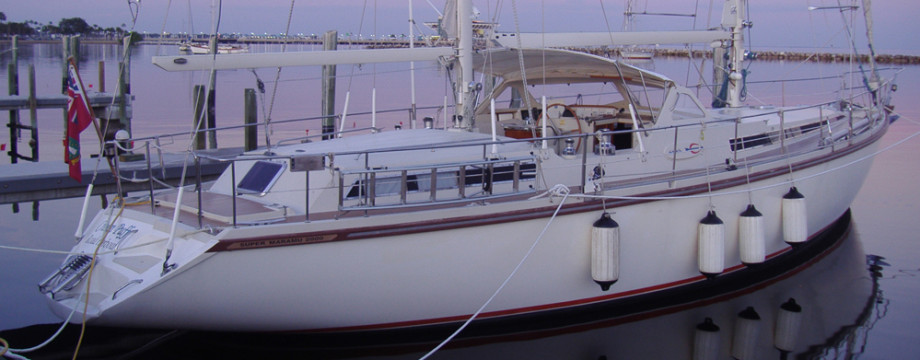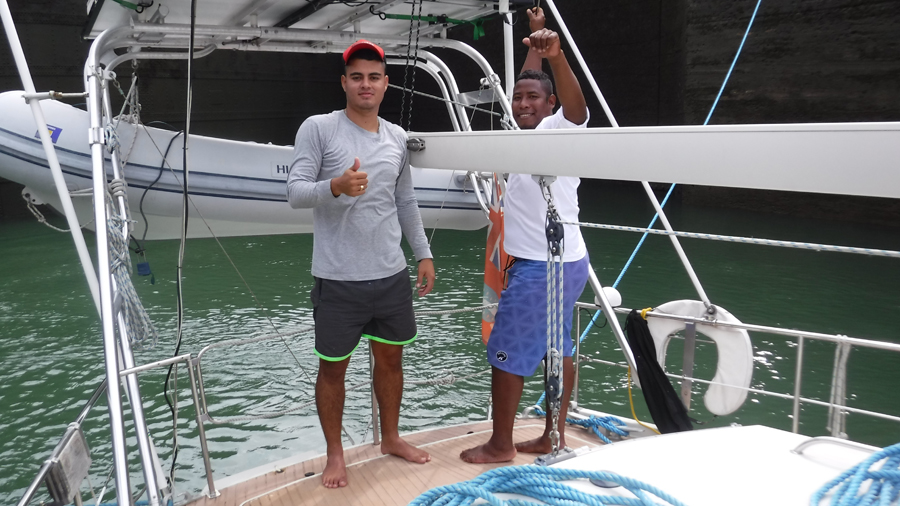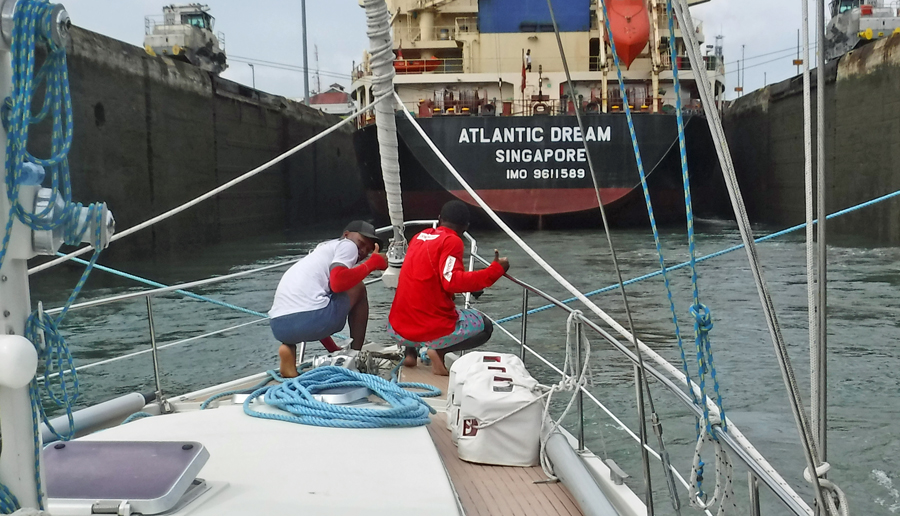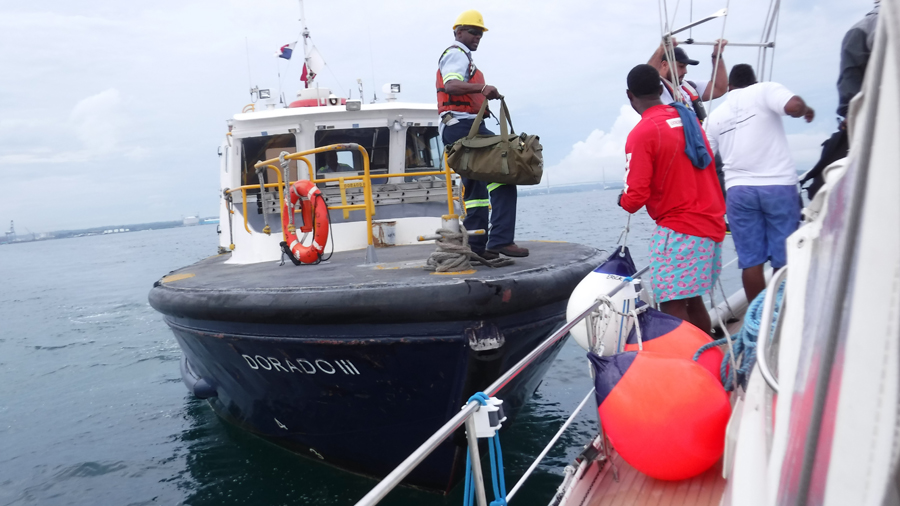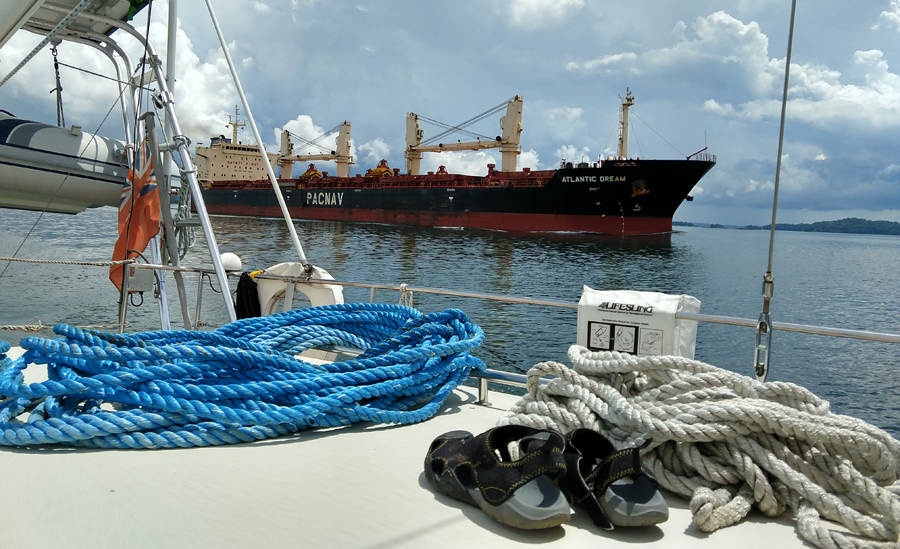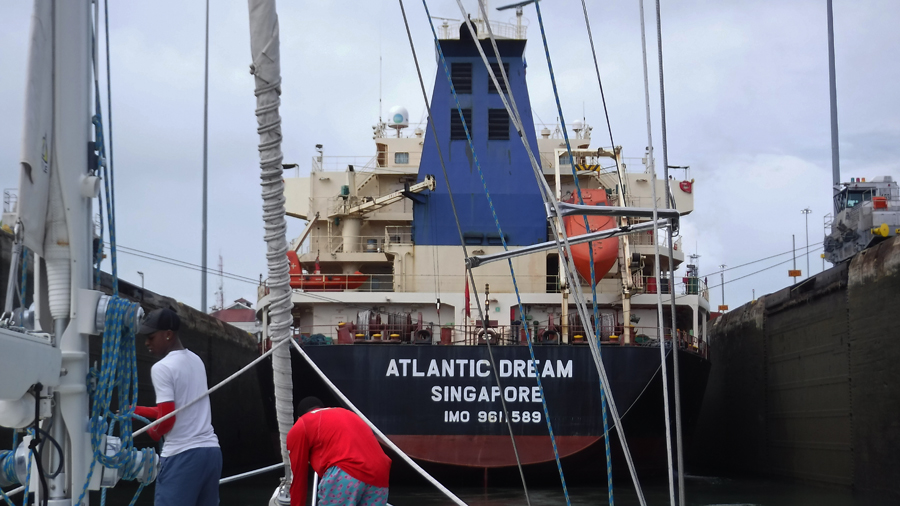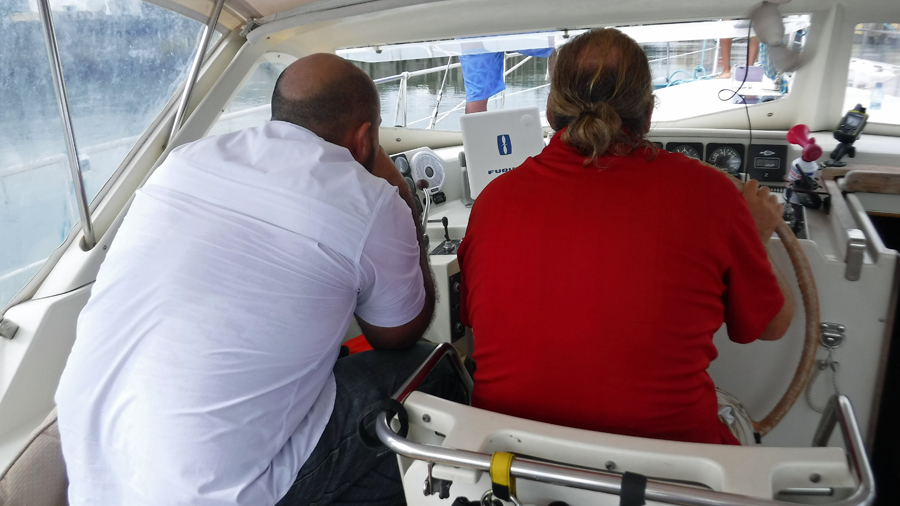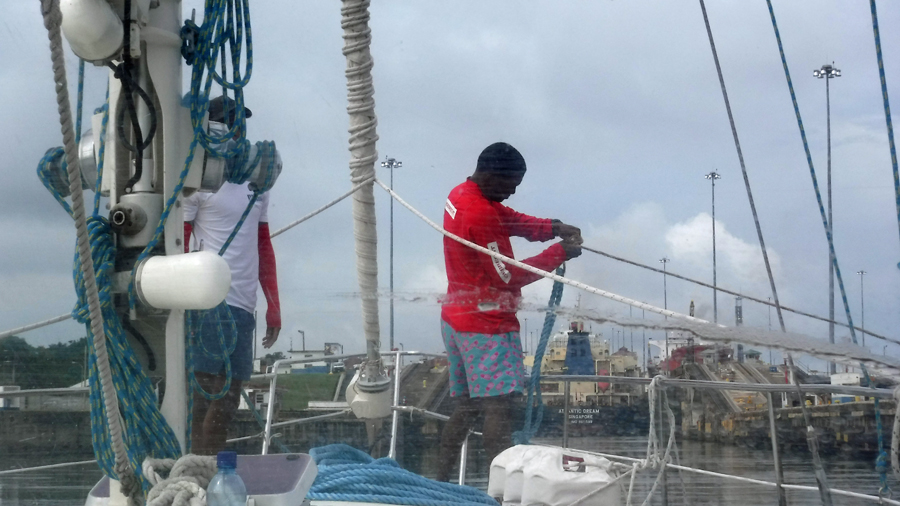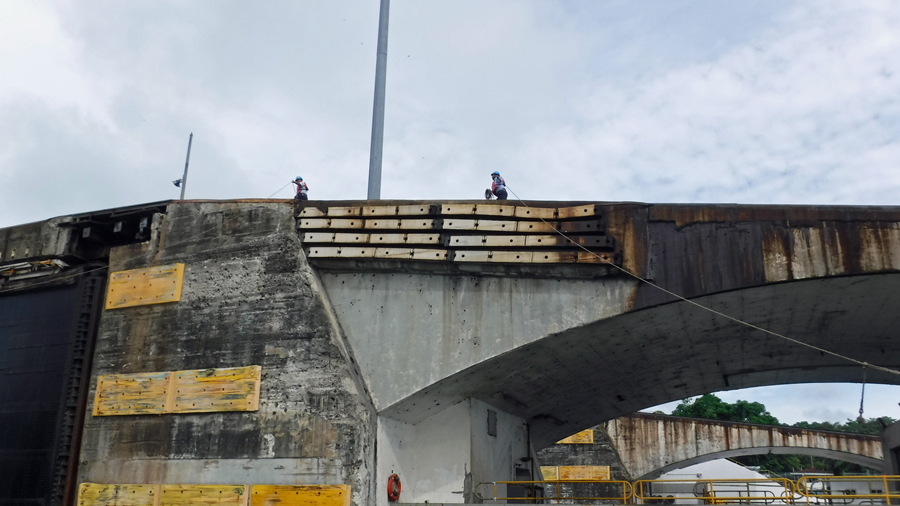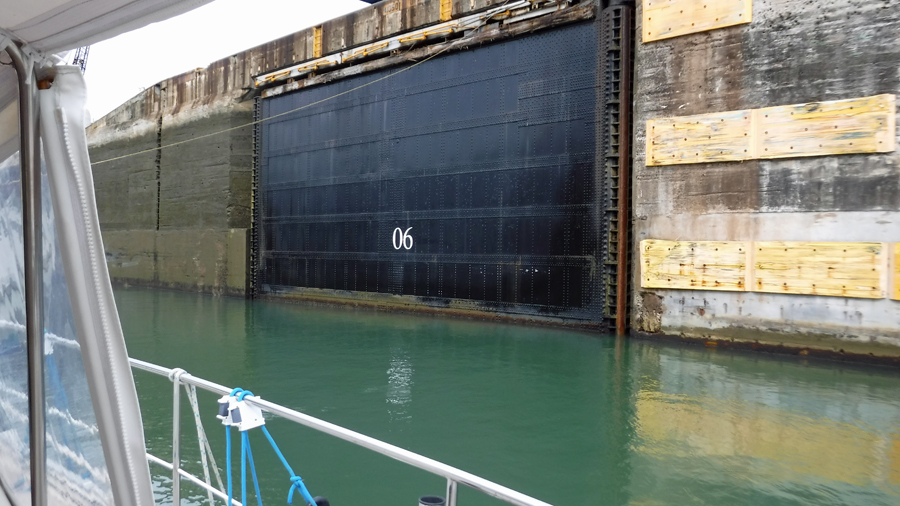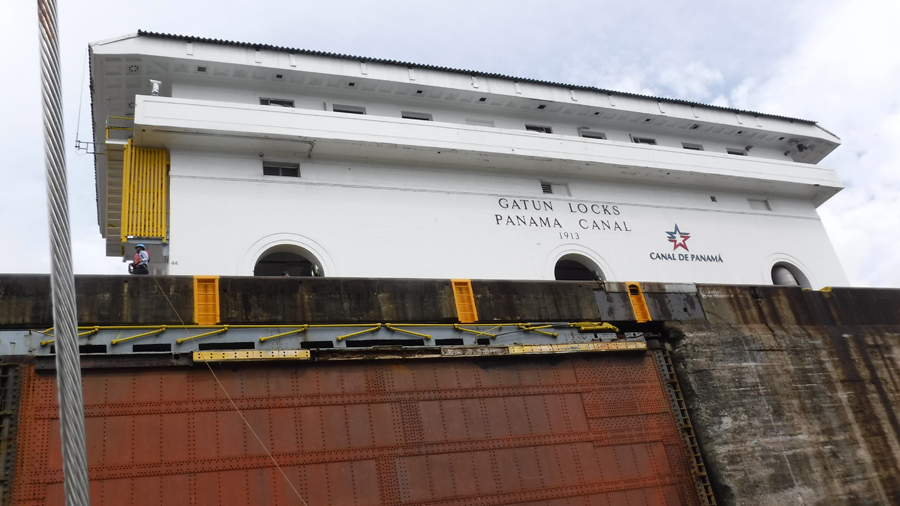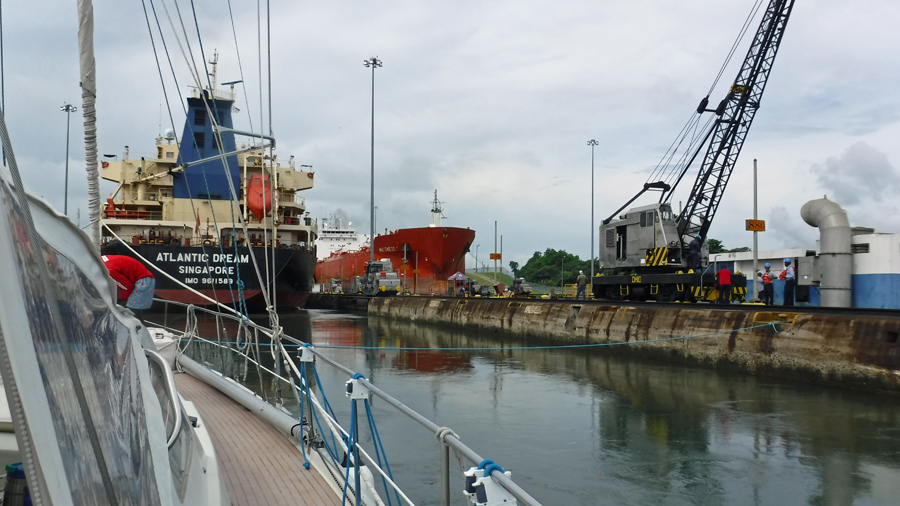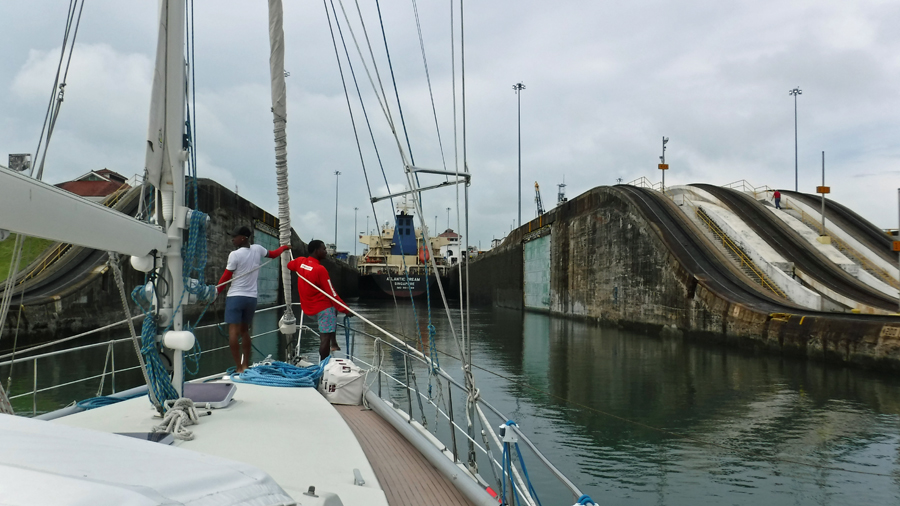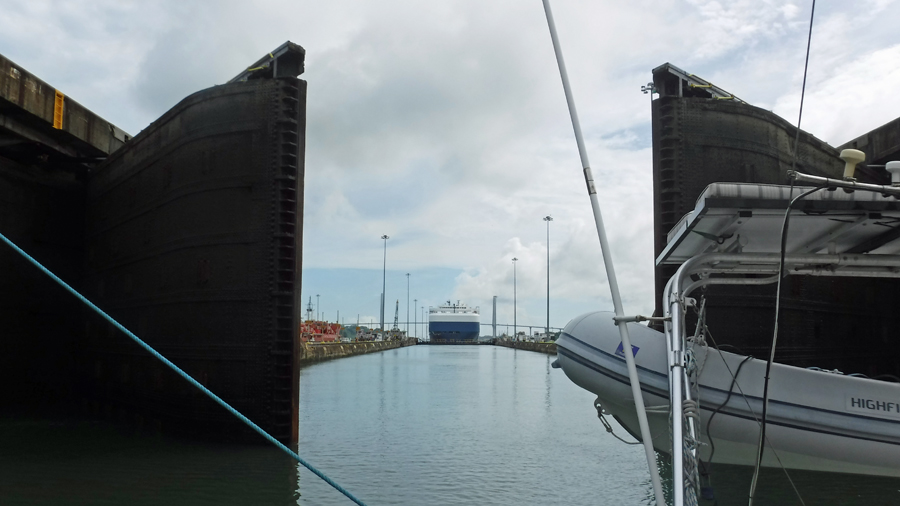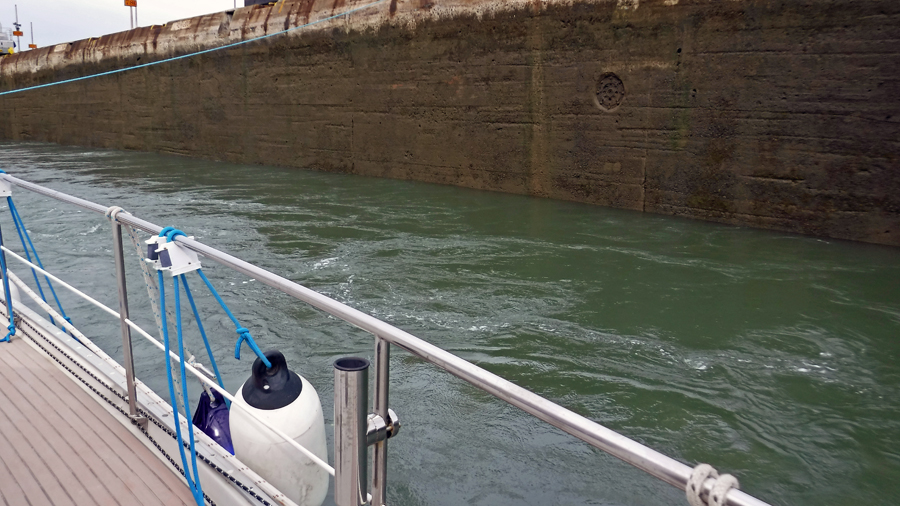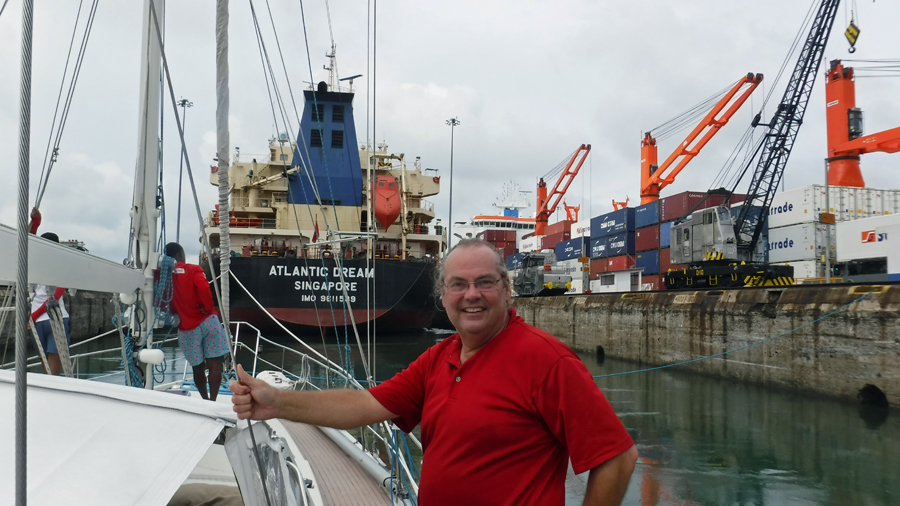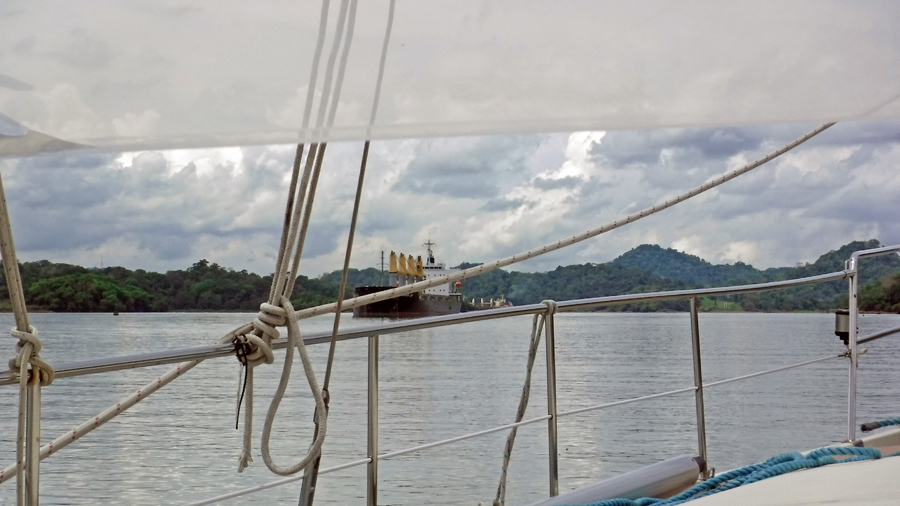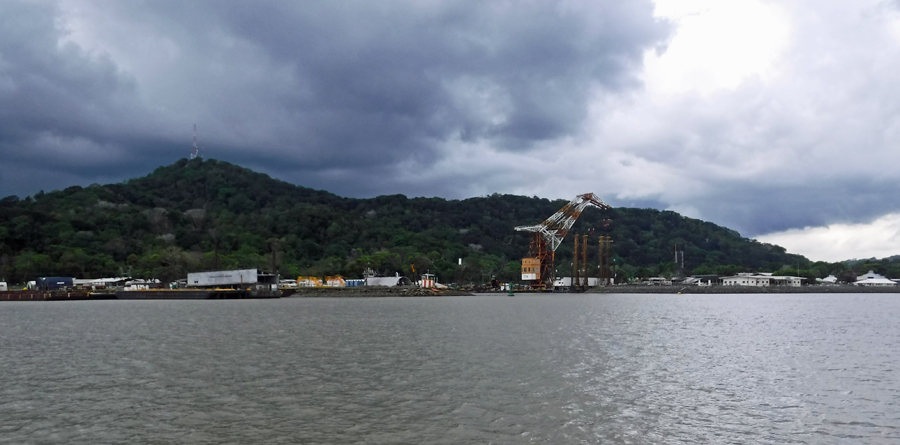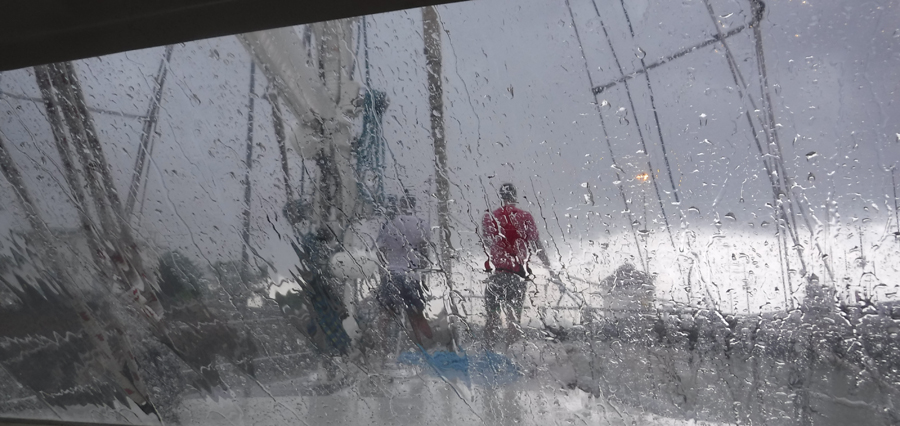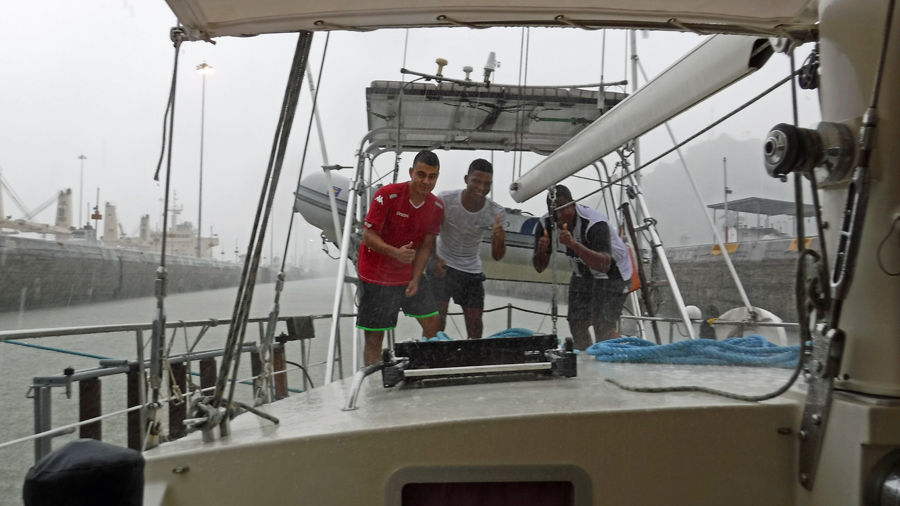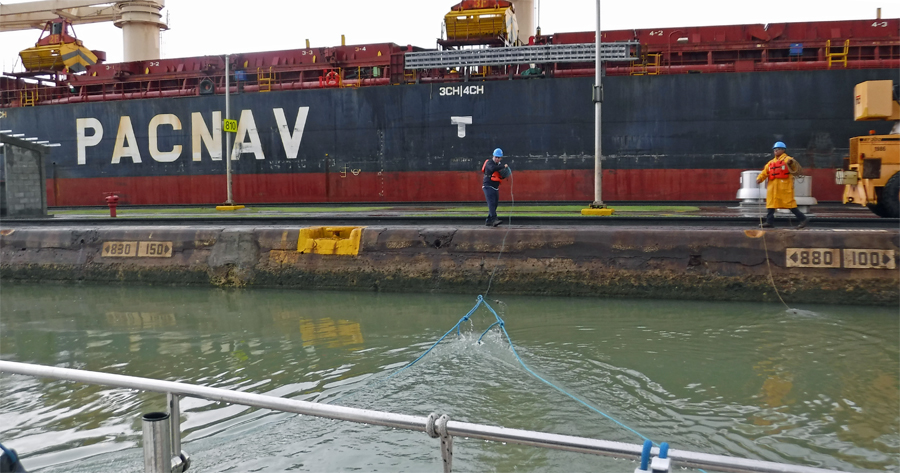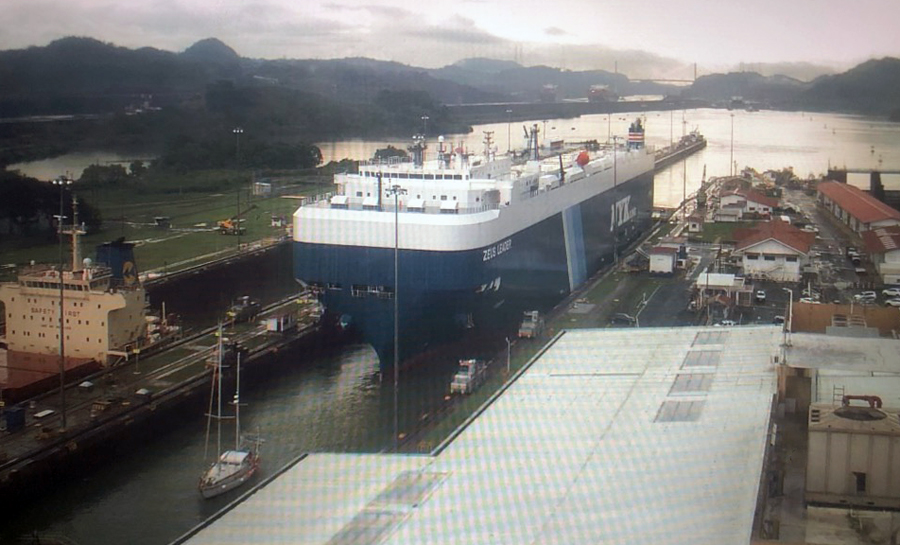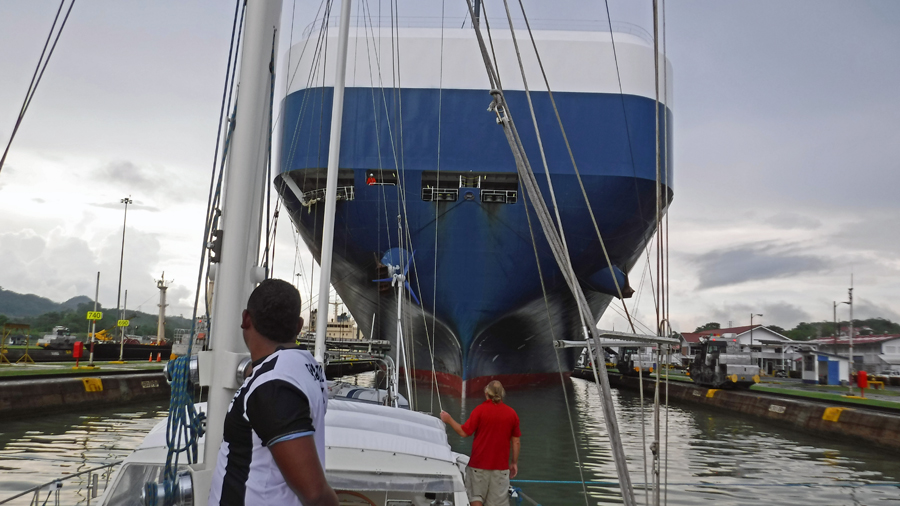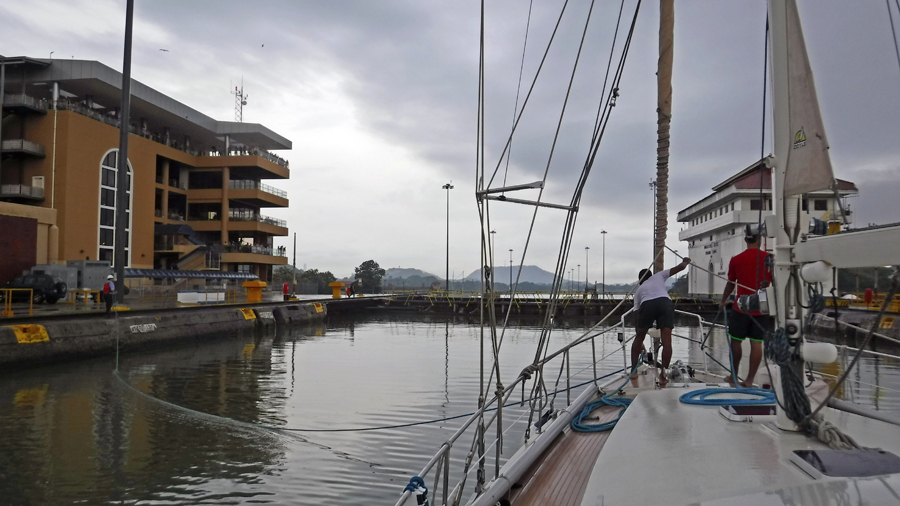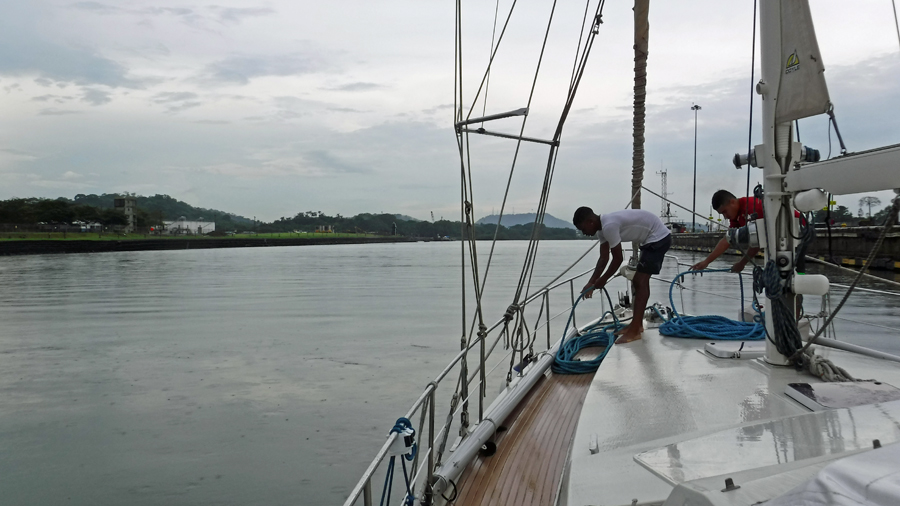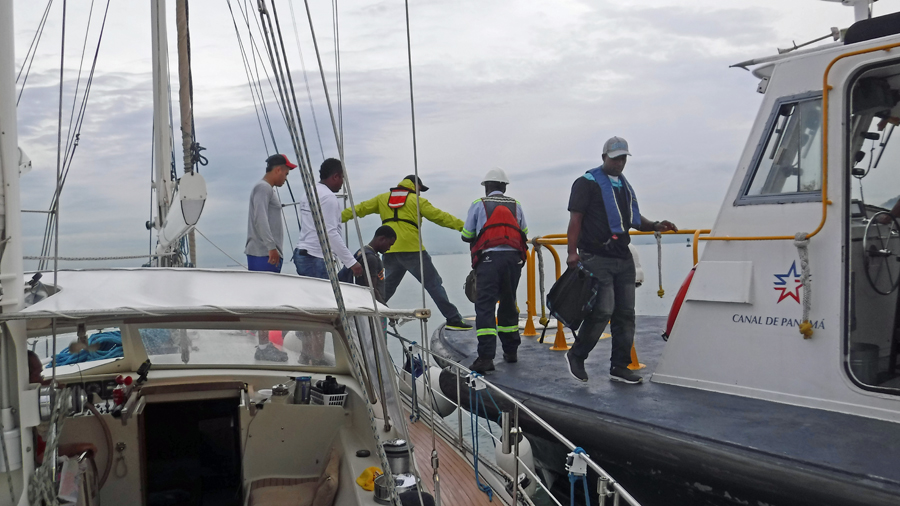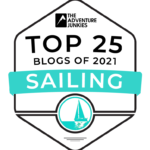Link to: Transiting the Panama Canal – Part One
5 am came too soon. This is it. This is the big day. I quickly brushed my teeth and got dressed. Going into the main salon and peeking in the forward cabin I see the line-handlers completely zonked out. I’ll make the coffee, I thought, that’ll wake them up. The coffee brewed and nobody stirred. I started the engine. Ha! That did the trick. The crew came to life. Cindy started to prep some breakfast and took over the coffee pot. She said it was really funny to look out the window and realize we are moving. Normally she is on deck working the lines as we leave the slip in the marina. The line-handlers helped me out of the marina.
We went to our designated rendezvous point. This was only about 10 minutes away, located just outside the marina. We had about 20 minutes before our adviser arrived. Cindy treated our line-handlers to an awesome breakfast of scrambled eggs, water-melon, croissants and juices. I think it is about time I referred to the line-handlers by name. They are Juan, Mario, Lewis and Mike who I will now refer to as “the guys” since I am really tired of typing the words line-handlers. While Cindy made breakfast, the guys put the ten extra large fenders we rented on the side of the boat and prepped their ropes for the trip. I radioed the Cristobal Signal Station to let them know we were ready and awaiting our adviser’s arrival. Erick has provided detailed instructions for every step of the transit. Juan and Mario spoke perfect English and had made the crossing hundreds of times. Breakfast was a hit.
At 6:30 am our advisers arrived. Yes, plural, advisers. Hector, who has been an adviser for 11 years had a trainee with him. This was Oswaldo’s eighth time to advise a boat through the canal and he was in command under the watchful eye of Hector. Oswaldo is in the training program to become a full fledge pilot who will guide the giant ships across the canal. Both were immediately offered coffee and pastries by Cindy. I gave them a quick overview of Cream Puff. We asked how many boats would be in our group and about our designated position inside the locks. The answer that came from Oswaldo was thrilling. We were going though alone, no rafting to other sailboats and our lock partner was a massive ship called Atlantic Dream. To quote Cindy, “This is the first class, premo, most sought after, make everyone on the dock jealous way to transit the canal”.
We hoisted our anchor and slowly motored toward the first lock. We had to wait for Atlantic Dream to get in front of us as during the first set of three locks we were to be positioned behind them. On the locks on the other side this position changes to us being in the front of the big ship. This is all due to the locamotives in the locks. During our short motor Oswaldo said he was pleased to see we had professional line-handlers. Both he and Hector knew our team from previous transits. He said this was going to make our day much easier; meaning he didn’t have to train them along the route. I really didn’t understand the impact of this statement until we got to the first set of locks.
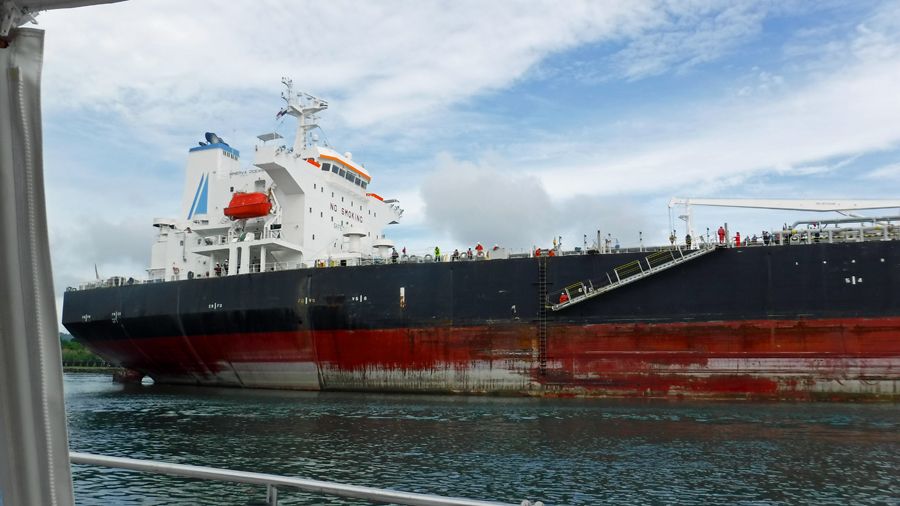
Things are up close and personal – at sea we try to give the ships at least 2 miles leeway. On the canal we see them smile as we wave.
Locomotives called mules are used to guide large ships in the locks. The ships move by their own power. A tug at the back of the ship acts as the brakes. They are steered by tugs before entering the locks and once in, the locomotives are used to keep the vessel in the center. Oswaldo told me the turbulence of the lock water can be felt even on the big ships. It takes years of training before an adviser reaches full pilot status. Once the pilot level is reached there are still eleven levels to achieve and it can take over fifteen years of training before the pilot handles the largest of ships going through the canal.
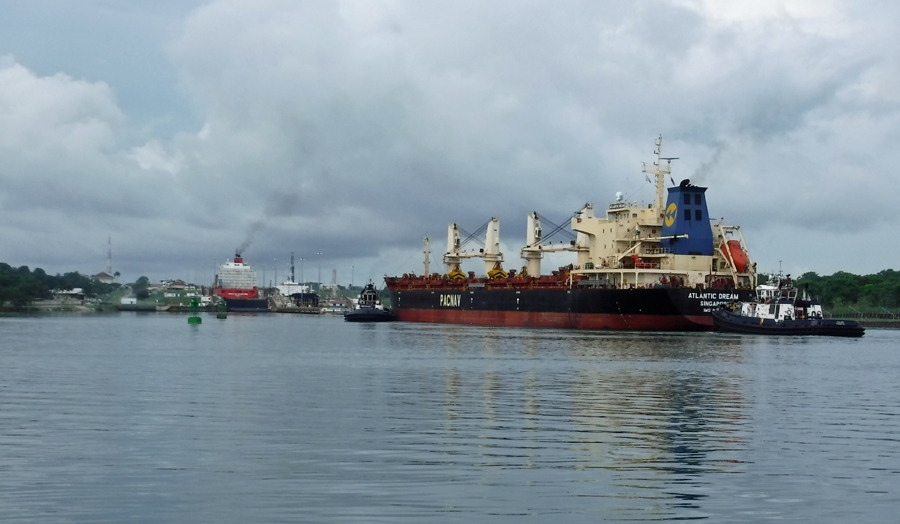
Atlantic Dream being aligned by tugs prior to entry – the tug on the back acts as a break when entering (it does not push). Ships move forward under their own power
I have to admit here, I was really nervous when approaching the first lock. There is an awful lot that can go wrong and very quickly. Oswaldo sat beside me and in a calm voice gave me perfectly clear instructions. His job is to guide me. My job is to execute the instructions. The guys were all in place. It is hard to explain how the currents swirl about inside the lock. A massive ship has just entered and displaced tons of water. This water needs to go somewhere. It comes towards us. Huge whirlpools form and if a small vessel gets too close to the side of the lock the water will suck it onto the concrete walls. There is a secret to entering and the procedure sometimes entails pointing the bow of Cream Puff toward the wall of the lock knowing the current is going to keep us in the middle. While all this is going on, four leader lines are thrown from the top of the lock for the guys to catch. The guys tie on heavy duty lines and these are pulled up to the top of the lock and secured. We are secured by four one inch thick ropes, one from each corner of the Puffster. As we rise in the lock the guys continue to pull in the slack keeping us in the middle. This is the only time Oswaldo and I can relax a little bit since we are now in the hands of the guys. It is now I realize the value of professional line handlers and Oswaldo’s statement. I recognize an adviser having to instruct inexperienced line-handlers and the skipper at the same time is a recipe for disaster. Not once entering the lock did we have to worry about the guys. They did exactly what they were supposed to do when they were supposed to do it. All of Oswaldo’s attention was on me.
The first set of locks, Gatun Locks, consists of three chambers. We rise 85 feet above sea-level in this series and enter Gatun Lake. We go from saltwater to freshwater. Moving from the first lock to the middle lock is much easier. The massive ship, Atlantic Dream, puts out a huge wash as the propeller starts to rotate. The guys keep us steady. Once the ship has moved forward, we follow. Again, there is tons of turbulence. The guys pull back the large heavy lines and the feeder lines stay attached as we move to the next lock. The line-men on the top of the locks walk the lines to the next position. Once there, the larger heavy duty lines are put back into place to secure us and behind us the lock doors close. The whole process is repeated. Not once did Oswaldo need to give instructions to the guys. Via his VHF radio, he is in constant communication with the dock operations and surrounding ships.
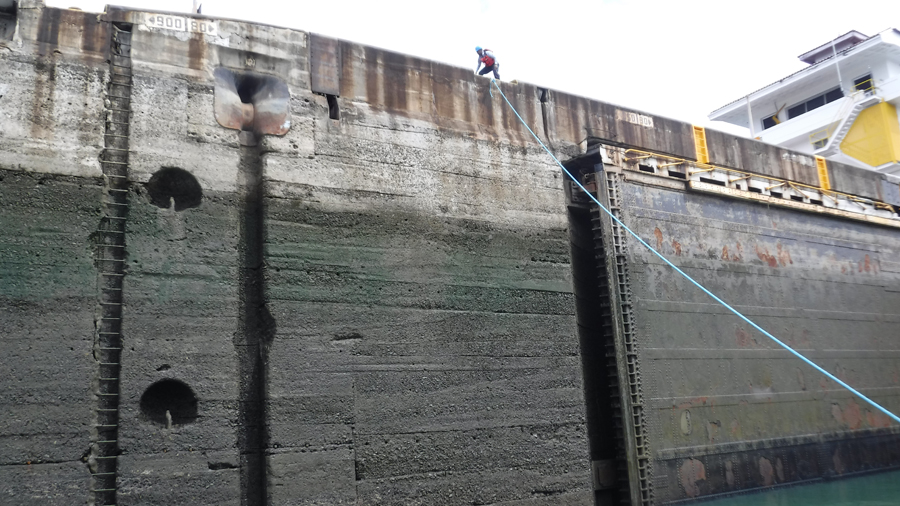
Securing our lines before the doors close and the water rises – The Guys pull in the slack line as we rise keeping us in the middle.
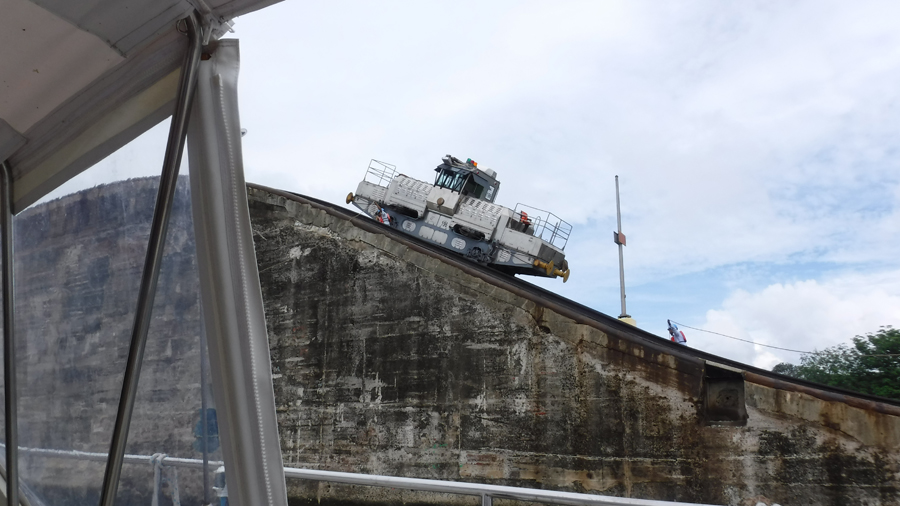
Cindy captures a mule moving past the line-men walking our lines up the stairs as we enter the next chamber
Exiting Gatun Locks I am amazed by the sheer beauty of my new surroundings. It is stunningly magnificent. The lake is calm and surround by tree-lined hills. The navigation channel is marked and I am instructed to stay on the side of the red buoys hugging the edge of the channel to leave plenty of room in the middle for the larger ships. We all become a bit too complacent with the calm waters and are caught a little off guard when a massive wake from a passing ship rocks us about. Cindy goes below to pass up some drinks for myself, Oswaldo and Hector. She comes up laughing. In the short time since our exit of the locks and me being caught up in awe of my new surroundings, we hadn’t noticed the guys all went back to bed. For them, it’s just another day.
It takes about 3 hours at 7 knots (8 mph or 13 kph) to cross the lake. We joked about stopping to have a swim (it’s so hot here) and Oswaldo chimed in. He said, there are tons of crocodiles in this lake. We saw one croc before the first set of locks but none in the lake. I’ll take Oswaldo’s word on this. About half way across, Cindy treated everyone to a fabulous lunch: Fresh green salad, French bread, paella and sweet potato pie for dessert with a side of fruit. The ice cold Coca-Colas were a big hit. Panamanians love their Coco-Cola. It is hard to find diet sodas here. They want the real thing. Hector and Oswaldo made a special point of thanking Cindy for a fabulous meal (her paella is awesome). The Cream Puff tradition continues. The guys came alive again with the smell of food.
We hear on the radio another sailboat radioing the Cristobal Signal Station. They were instructed by their adviser to contact the Canal Authority because they had run out of bottled water. Oswaldo and Hector laughed. Oswaldo said, “That’s going to cost them”. He explained that when a boat runs out of bottled water or food for the advisers, it is delivered to the vessel. The cost of the water is $10. The delivery fee by boat is $400. He asked us if the water and food requirement was clearly explained by the ACP inspector. We told him it was very clear. Then we told him about the ladies on the bus. We couldn’t help but wonder if it was same people. To expect people to work outside without water in this heat is insane. Our entire crew of eight drank about 30 bottles of water during the one day passage.
On the east side of the canal, we had all been watching a storm brew. It is the beginning of the rainy season and it rains every afternoon in central Panama. During the height of the rainy season it will rain most of the day every day. We all agreed, we’re about to get wet. Trying to be the glass half full person, I was thinking we might get ahead of the rain. A massive clap of thunder quickly changed my mind. The sky opened up and it rained hard. We are fortunate on Cream Puff to have a hard dodger and vinyl bimini to protect us. Cindy, Oswaldo, Hector and I could stay dry in the cockpit. The guys hung out below hoping it would stop before they had to get back into action at the next lock.
It didn’t let up as we approach the next lock. We are now going to head back down to sea-level. This is the Pedro Miguel Lock. It is a single lock followed by a quick motor across Miraflores Lake to the last two locks, Miraflores locks. It is raining hard and the guys embrace the weather with huge smiles. Mario decides to get wet quickly and lays face-up on the foredeck making snow angels in the rain. Visibility is limited now and we have a massive blue and white car-carrier ship on our tail. Oswaldo and I are both keeping an eye on our navigation monitor displaying AIS and radar. Should it rain harder, this will be our eyes. On the downward locks we enter first and the ship comes in behind us. Once again, Oswaldo seats himself next to me and offers clear precise and calm instructions. We enter the churning waters of the lock and position ourselves exactly where we needed to be. Hector, a man of few words, looks over and says, “That was perfect, well done!” Oswaldo and I fist bump. It’s a team effort.
Because of the limit visibility, Mike was hit by an incoming monkey fist. It nailed him on top of the head. Ouch! The line-man on the top of the lock failed three times to get the leader line to Cream Puff. We do not stop. Nor, do we move closer to the side where the danger lies. Our quick thinking professionals used the other line that was thrown successfully to that side of the boat and tied both heavy duty lines to the one feeder. The linemen on the top of the lock managed to haul both heavy lines up and secure them. This was done in the nick of time just as we reach our lock position. A great example of professionals being proactive rather than reactive.
The water level of the lock lowers and I get a kick out of watching our depth gauge adjust. The guys are soaked. The gates open and their job is done for the next few minutes. Cindy hands out towels but they refuse them and say they’ll save the towel for when it stops raining. It doesn’t take long before we reach the last set of locks. On the side of these locks is a massive tourist center with hundreds of people watching us as we approach. Pressure is on to perform. Oswaldo and I nail it again: Another fist bump. The big ship behind us gets into a little bit of trouble and starts to turn sideways before entering the lock. Oswaldo is monitoring their communications between the pilot and lock crew. The pilot remains calm and makes the corrections. I ask Oswaldo if he is sure that he wants that job one day. The gleam in his eye confirms it. When the gates close we move down closer to sea-level. One more lock to go.
Because we are in front of the big ship, we need to immediately get out of the way. As soon as the lock doors open allowing us to go to the next chamber, Oswaldo toots our horn. All the lines immediately go slack and we quickly go forward. The guys quickly clear the four lines from the water to avoid any chance of becoming entangled in our now spinning propeller. Oswaldo communicates to the ship behind us that we are clear since they can’t see us. Their pilot puts the ship in gear and instantly we feel the turbulence from their massive propellers. They move into the next chamber behind us. At this point many of our friends have been following us on the live streaming webcams at the locks. Cindy receives a couple of text like, “I hope that big ship has brakes!” We received this picture and thought it would be cool to text back one from our prospective.
We knew Cindy would have her hands full taking care of eight people all day which is another reason we hired four line handlers rather than three. Cindy stayed busy documenting our trip in photos, fielding texts from family and friends who were watching us on the cameras, dishing out delicious meals and snacks during the crew’s downtime, keeping people hydrated and just generally pampering our guests during the transit. Having the webcams in the canal allowed friends and family to text us and send screen shots of Cream Puff in the locks. It was wonderful having them all be part of the adventure through modern technology. The only real downtime the Advisers, Cindy and I had was while water in the locks were filling or emptying. That is the time we all stopped and took it all in. However this was the crucial time for the guys who were busy taking care of the lines with the changing water levels.
It had almost stopped raining. The sun was out and we were in the last lock in front of the visitor’s center. Oswaldo warns me that when the doors open and we leave the lock, the water will be very turbulent, more so than it has been. This is due to the ship behind us going into gear and the mixing of freshwater from the lake with seawater from the Pacific. The doors open, the horn is tooted one last time. The lines go slack and I immediately go to 70% power. We quickly clear the lock and Oswaldo radios back that we have cleared. We receive kudos from the big ship’s pilot for clearing so quickly and when he goes into gear we feel Cream Puff pushed from side to side but we are already well away from the concrete walls. It doesn’t take long before we are out of the turbulence. For the very first time, Cream Puff touches the waters of the Pacific Ocean.
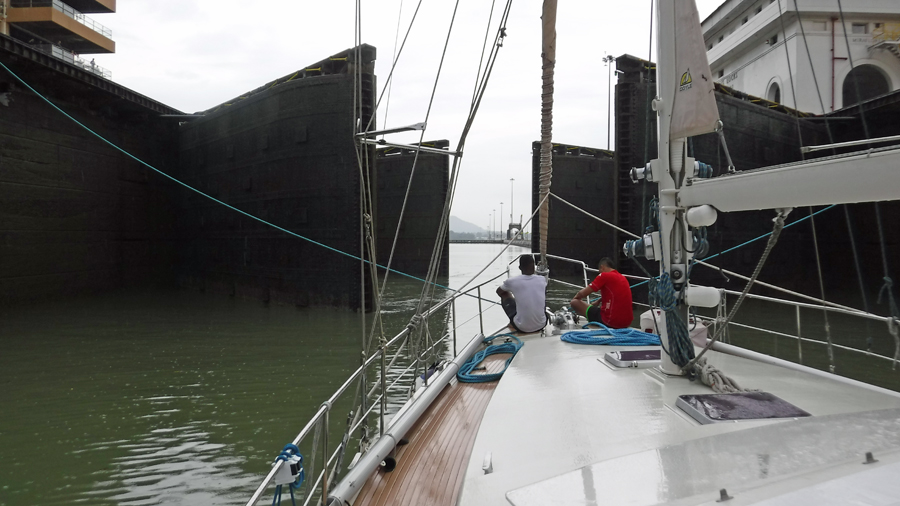
The lock doors opening. Cream Puff waiting to move to the last lock before the Pacific Ocean. The guys working the ropes but staying low for safety and out of the line of sight.
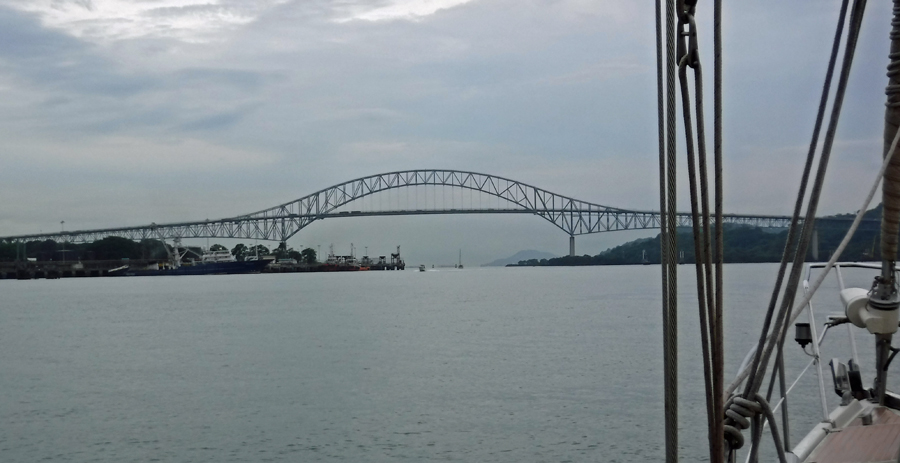
The sun comes out as we approach Bridge of the Americas that bridging the north and south continents
The remainder of the journey is very mundane compared to the earlier events of the day. The guys remove the massive fenders we rented to protect Cream Puff’s hull. Because of the professionals on board we never came close to the side of the locks. The guys coiled their heavy duty ropes in preparation for their departure and then disappeared to put on dry clothes. We followed the channel markers to the Balboa Yacht Club where we plan to spend the night on a mooring and drop off the advisers and the guys. Inside of Cindy and myself (besides the huge relief) is a feeling of euphoria. We have just completed a journey many sailors only dream about. For the past 21 days, since leaving the San Blas Islands, we have been planning this. Now we have achieved it. Holy cow! We’re in the Pacific!
